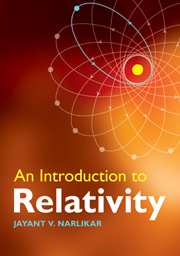Book contents
- Frontmatter
- Contents
- Preface
- 1 The special theory of relativity
- 2 From the special to the general theory of relativity
- 3 Vectors and tensors
- 4 Covariant differentiation
- 5 Curvature of spacetime
- 6 Spacetime symmetries
- 7 Physics in curved spacetime
- 8 Einstein's equations
- 9 The Schwarzschild solution
- 10 Experimental tests of general relativity
- 11 Gravitational radiation
- 12 Relativistic astrophysics
- 13 Black holes
- 14 The expanding Universe
- 15 Friedmann models
- 16 The early Universe
- 17 Observational cosmology
- 18 Beyond relativity
- References
- Index
2 - From the special to the general theory of relativity
Published online by Cambridge University Press: 05 June 2012
- Frontmatter
- Contents
- Preface
- 1 The special theory of relativity
- 2 From the special to the general theory of relativity
- 3 Vectors and tensors
- 4 Covariant differentiation
- 5 Curvature of spacetime
- 6 Spacetime symmetries
- 7 Physics in curved spacetime
- 8 Einstein's equations
- 9 The Schwarzschild solution
- 10 Experimental tests of general relativity
- 11 Gravitational radiation
- 12 Relativistic astrophysics
- 13 Black holes
- 14 The expanding Universe
- 15 Friedmann models
- 16 The early Universe
- 17 Observational cosmology
- 18 Beyond relativity
- References
- Index
Summary
Space, time and gravitation
The special theory of relativity reviewed in the last chapter marked a major advance in physics. The basic assumption that the fundamental laws of physics are invariant for all inertial observers looks at first sight a reasonable premise. However, as we saw in Chapter 1, its application to Maxwell's equations of electromagnetic theory led to a drastic revision of how such observers make and relate their measurements of space and time. One consequence was that the Newtonian notions of absolute space and absolute time had to be abandoned and replaced by a unified entity of spacetime. The Galilean transformation relating the space and time measurements of two inertial observers had to be replaced by the Lorentz transformation. Strange and non-intuitive though the consequences of this transformation were, as we saw in Chapter 1, several experiments confirmed them.
In spite of these successes, Einstein felt that the special theory addressed limited issues. For example, what was the nature of physical laws when viewed not in the inertial frames of reference, but in an accelerated one? Was there some more general principle that, when applied to these laws, preserved their form? Intuitively Einstein felt that some such situation must prevail. But that required a formalism more general than that provided by the Lorentz transformation.
On another matter, of the two classical theories of physics known in the first decade of the twentieth century, the electromagnetic theory had played a major role in the genesis of special relativity.
- Type
- Chapter
- Information
- An Introduction to Relativity , pp. 34 - 40Publisher: Cambridge University PressPrint publication year: 2010



